CFTT13
| SITE: CFTT 13 | Site: Flynns Creek |
| Location: APP species/seedlot trial VRV147 | Aust. Soil Class.: Bleached-Vertic, Magnesic, Grey CHROMOSOL |
| Great Soil Group: soloth | Tech. Class: 052-6-50/2-1-3-32 |
| General Landscape Description: Level to gently undulating plain | Geology: Late Tertiary sediments |
| APP Mapping Unit: Stockdale | |
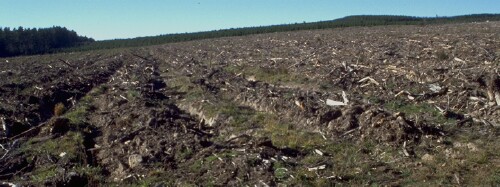
CFTT13 Landscape
Soil Profile Morphology:
Surface Soil
| A1 | 0 – 15 cm | Dark brown (10YR3/3) sandy loam; weak medium angular blocky structure (less than 20 mm) parting to weak granular structure (less than 5 mm); weak consistence moderately moist; pH 4.8; clear and smooth transition to: | 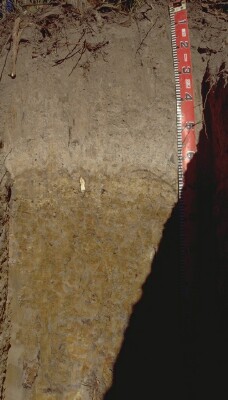 CFTT13 Profile |
| A21 | 15 – 40 cm | Brown (10YR5/3) sandy loam, sporadically bleached; slightly fine gravelly, subrounded quartz; massive; very firm dry; pH 5.2; clear and smooth transition to: | |
| A22 | 40 – 60 cm | Pale brown (10YR6/3), conspicuously bleached (10YR8/2 dry), clayey sand; slightly fine gravelly, subrounded quartz; massive; very firm dry; pH 5.1; clear and smooth transition to: | |
| Subsoil | |||
| B1 | 60 – 70 cm | Pale brown (10YR6/3), common, fine, faint, brownish yellow (10YR6/6) mottles, sandy clay; slightly fine gravelly, subrounded quartz; weak medium angular blocky structure; very firm moderately moist; pH 5.5; abrupt and smooth transition to: | |
| B21 | 70 – 100 cm | Light brownish grey (10YR6/2); with many, coarse, prominent, brownish yellow (10YR6/6) with red (2.5YR5/8) mottles; medium clay; moderate coarse prismatic structure, parting to moderate medium lenticular structure; very firm consistence, moderately moist; pH 5.9; gradual and smooth transition to: | |
| B22 | 100 – 140 cm | Pale brown (10YR6/3), many, coarse, prominent, brownish yellow (10YR6/8) with red (2.5YR5/8) mottles, medium clay; strong, coarse prismatic structure, parting to strong coarse angular blocky structure; very firm moderately moist; pH 6.4. | |
| C | Soft decomposing sandstone from 1.4 m to 2.0 m - sandy clay in overall texture. | ||
Key Profile Features:
- Strong texture contrast between surface (A) horizons and subsoil (B) horizons
- Bleached subsurface (A2) horizons
pH | Salinity Rating | |||
Surface (A1 horizon) | Very strongly acid | Very low | Non-sodic | none |
Subsoil (B21 horizon) | Moderately acid | Very low | Non-sodic | none |
Deeper subsoil (at 1 m) | Slightly acid | Very low | - | none |
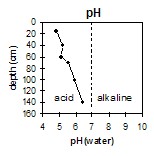 The soil profile becomes less acid with depth. | 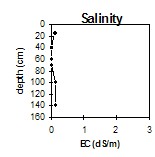 The level of soluble salts is low throughout. | 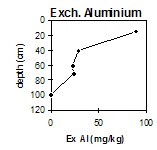 The level of exchangeable aluminium is higher in the very strongly acid surface soil. | 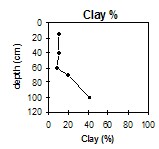 The clay content increases significantly at the A/B horizon interface. |
Horizon | Horizon Depth | pH (water) | pH CaCl2 | EC 1:5 | NaCl | Exchangeable Cations | |||
Ca | Mg | K | Na | ||||||
Meq/100g | |||||||||
A1 | 0-15 | 4.8 | 4 | 0.09 | 1.9 | 1.1 | 0.12 | 0.23 | |
A21 | 15-40 | 5.2 | 4.4 | <0.05 | 0.57 | 0.62 | <0.05 | 0.07 | |
A22 | 40-60 | 5.1 | 4.3 | <0.05 | 0.23 | 0.39 | <0.05 | 0.05 | |
B1 | 60-70 | 5.5 | 4.5 | <0.05 | 0.62 | 1.8 | <0.05 | 0.18 | |
B21 | 70-100 | 5.9 | 5.1 | 0.11 | 1.2 | 7.3 | 0.11 | 0.77 | |
B22 | 100-140 | 6.4 | 5.7 | 0.11 | 0.18 | 6.9 | 0.08 | 1.1 | |
Horizon | Horizon Depth | Ex Al mg/kg | Ex Ac meq/100g | Field pF 2.5 | Wilting Point pF4.2 g/100g | Coarse Sand (0.2-2.0mm) % | Fine Sand (0.02-0.2mm) % | Silt (0.002-0.02mm) % | Clay (<0.002mm) % |
A1 | 0-15 | 89 | 13 | 17 | 6.7 | 48.4 | 23.4 | 13.5 | 10 |
A21 | 15-40 | 28 | 2.1 | 11.6 | 3.4 | 49.7 | 25 | 15 | 10 |
A22 | 40-60 | 22 | 4 | 10.2 | 2.6 | 49.5 | 25.2 | 18.5 | 9 |
B1 | 60-70 | 23 | 4.9 | 14.2 | 6.1 | 39.4 | 24.6 | 16.5 | 19.5 |
B21 | 70-100 | <10 | 7.4 | 28.6 | 17.8 | 19 | 10.6 | 7 | 41.5 |
B22 | 100-140 | 5.8 | 25.8 | 16.3 | 33 | 14.8 | 5 | 45 |
Management Considerations:
- The subsoil has a very low exchangeable calcium:magnesium ratio. Calcium deficiency could occur as a result.
Profile described by: Ian Sargeant, Mark Imhof and Justin Wong (9/6/99)


